The “Only in America” Tour—Part 10
Cadillacs, Combines, and VW Bugs:
Amarillo’s Quirky Americana
Texas boasts approximately 248,00 ranches and farms, but none is as unique as Cadillac Ranch. Located in Amarillo near historic Route 66, this unusual public art installation features a row of ten Cadillacs half-buried nose-down in the ground at a sixty-degree angle corresponding to that of the Great Pyramid of Giza, in Egypt. The Cadillacs face west in a line, from the 1949 Club Sedan to the 1963 Sedan de Ville—a tribute to the American Dream and the evolution of Cadillac tailfins.
In his online article, “The Automobile’s Indelible Mark on America,” Tom Merola writes: “Beyond the practicalities of transportation, the automobile embodies the spirit of American innovation and freedom. It represents the ability to explore new frontiers, seek opportunities, and achieve personal independence. This sense of freedom is deeply ingrained in the American psyche, reflecting the nation’s pioneering heritage and its ongoing quest for progress and self-determination.”
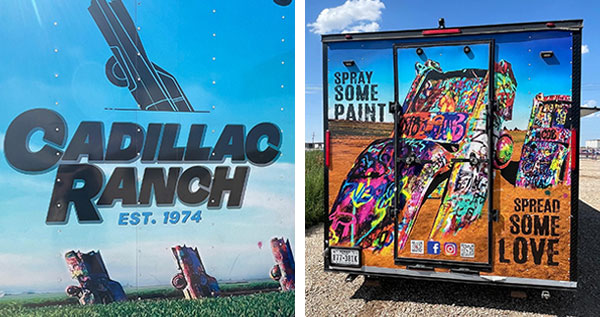
Cadillac Ranch was created in 1974 by Chip Lord, Hudson Marquez, and Doug Michels—a group of art-hippies from San Francisco who called themselves “The Ant Farm.” The project was funded by Stanley Marsh III, an eccentric Amarillo billionaire, and it was originally built in one of his wheat fields. In 1997, Cadillac Ranch was relocated two miles west to another of Marsh’s fields to place it farther from the growing city. Before his death in June 2019, Marsh transferred his ownership of Cadillac Ranch into a family trust.
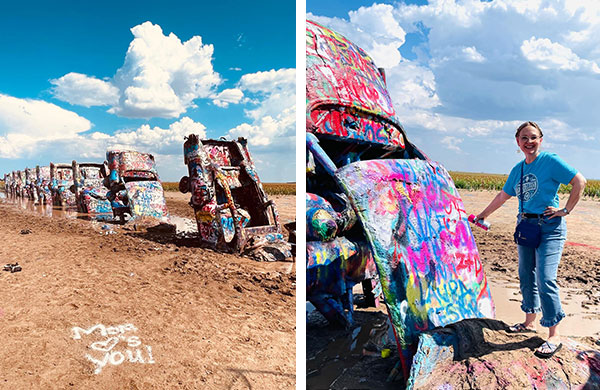
My friend Thea and I encountered Cadillac Ranch in its present location—an open pasture surrounded by fields of sorghum. The site is open 24 hours a day, 365 days a year, and there is no admission fee. It had rained the night before our visit, and the ground around the Cadillacs was a muddy mess. Nevertheless, I persevered. Some people “paint the town”; others “spray paint” it. Cadillac Ranch was designed to be an interactive art installation, and visitors are encouraged to add their own decorative touches. I bought a can of pink spray paint and proceeded to write “M & M” on the hood of a Cadillac. How fun!
I read that the Cadillacs are periodically painted different colors. Once they were all given a coat of white for the filming of a TV commercial. Another time they were painted pink in honor of the birthday of Marsh’s wife Wendy. And when the artist Doug Michels died, the cars were colored black to mark his passing. Sometimes the Cadillacs are painted a solid color simply to provide a fresh canvas for future visitors.
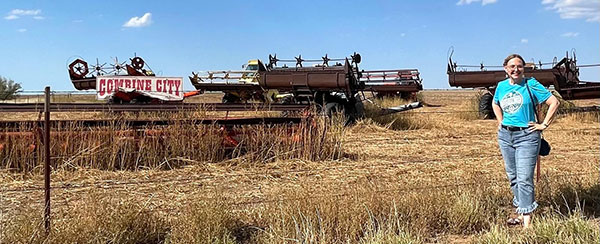

If imitation is the sincerest form of flattery, then Cadillac Ranch has received two big compliments. About 20 miles away in Lake Tanglewood lies Combine City, another art installation composed of retired combine tractors sunk at an angle in a remote farm field. This roundup of machines, however, is not interactive: a barbed wire fence surrounds the tractors to prevent visitors from getting closer, and there is no invitation to add your own colorful embellishments. But this is understandable. The combines’ star wheels—used to engage with the crop and guide it through the machinery—have sharp, rusty projections that just scream “tetanus shot” to the ears of a pediatrician’s wife.
Another off-shoot of Cadillac Ranch is the Bug Ranch. Once called the “Slug Bug Ranch” and located along Route 66 near Conway, this art installation has nothing to do with insects, although they do grow ‘em big down south. In the original location, the owner Tommy Crutchfield (or perhaps his brother Ricky—there is some dispute about this among the family) took five Volkswagen Bugs and half-buried them nose down as a tribute to Cadillac Ranch.
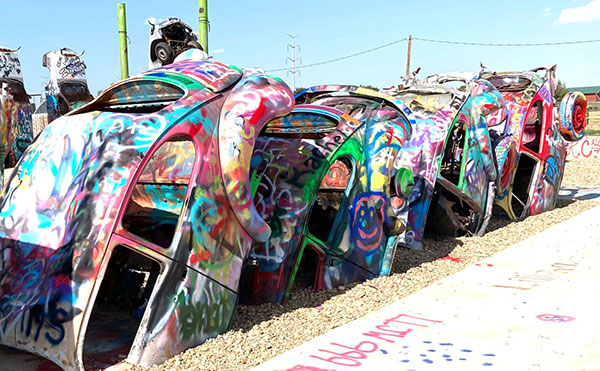
Slug Bug Ranch opened in 2002 but closed in 2023 as Conway became a ghost town. The VW installation was then purchased by the Big Texan Steak Ranch and moved to a new, more prominent position along Interstate 40 in Amarillo. It reopened as the Bug Ranch in June of 2024.
Happily, I still had some pink spray paint left in my can when Thea and I arrived at the new installation. The whole complex is beautifully arranged with concrete sidewalks that are friendly to folks with disabilities. I myself was tickled not to wade again through mud.
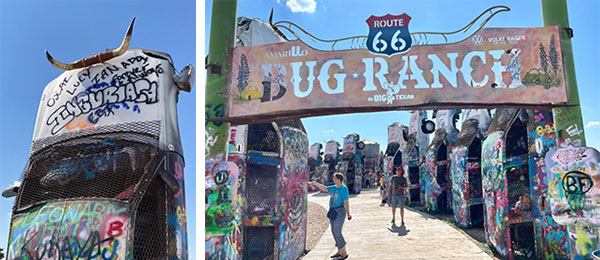
Several more VW Bugs have been added to Crutchfield’s original five as well as a number of similarly buried stretch limousines. I especially liked the steer horns mounted on the limo hoods. The American journalist Bill Moyers says, “Creativity is piercing the mundane to find the marvelous.”
The Bug Ranch is owned by the nearby Big Texan Steak Ranch—home to the restaurant where we ate dinner, the motel where we spent the night, and a swimming pool shaped like the state of Texas. Only in America. The restaurant has been family-owned and run since 1960. It is famous for its 72-ounce (4.5 pound) USDA top sirloin steak. If you can consume one of these whoppers—along with a baked potato, a shrimp cocktail (usually three shrimp), a dinner roll and a salad—in less than an hour, your dinner is free. Apparently, one of out every ten men and one out of every three women who attempt this feat are successful. Presumably, the female aspirants have greater self-awareness.
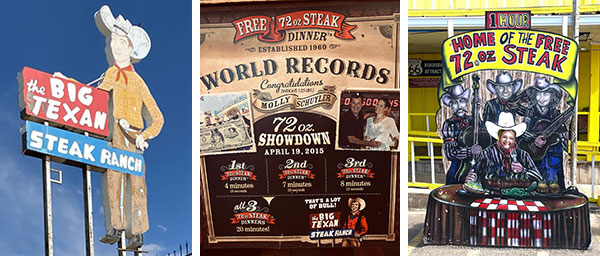
Curiously enough, the world record holder for the 72-ounce showdown is a 125-pound woman named Molly Schuyler. On April 19, 2015, she ate her first 72-ounce steak dinner in 4 minutes, 18 seconds. This set a world record. Immediately after that, Schuyler consumed her second 72-ounce steak dinner in 7 minutes, 29 seconds. And finally, she finished off her third 72-ounce steak dinner at a more leisurely pace of 8 minutes, 13 seconds. Schuyler set a world record for eating three 72-ounce steak dinners in one sitting in 20 minutes.
In the July 4, 2025 episode of NPR’s All Things Considered, the author Jason Fagone says that an eating contest is “symbolic of the outsized American appetite for everything, not just for food, but for resources, power, money. You name it. It’s kind of a Rorschach test for how people see us.” At the very least, America touts the adage, “Bigger is better.”
During the meal that Thea and I enjoyed at the Big Texan, two men sat at the restaurant’s elevated head table under a time clock and took up the 72-ounce challenge. Neither could choke down all that meat in one hour, so each had to cough up $72.00 to pay for his meal. Wisely, I think, Thea and I stuck to more reasonable portions.
When we praised our server on the special spices topping our dishes, she brought us each a pint jar full of the house seasoning. (Note: our compliments on the seasoning, which complemented the steak, did not make the goods complimentary.) Thea and I carried these glass containers home in our hand luggage. Both of us were stopped by airport security officers who had to inspect and test our tasty souvenirs. Only the flavor, I am happy to report, was explosive.
I fell in love with Amarillo’s quirky Americana. In the Texas panhandle, the land is flat, the sky is big and blue, and automobiles and tractors bloom out of the earth. How fun and flattering that art imitates art, which imitates life! There is a certain expansiveness, freedom, creativity, and optimism here that makes my heart sing. I appreciate the flexibility displayed in a willingness to move things to better locations. I cheer the hutzpah of a hotel with a Texas-shaped swimming pool. And—against my better nutritional judgment—I applaud a 125-pound woman who can take a seat among the big boys at the head table.

Please encourage your friends and family to subscribe at: justaboutanything.life
Please encourage Mona at: encouragemona@gmail.com
I included a pdf download link below, which will print out nicely for all of my paper-loving readers.
Please feel free to share it with your family and friends.
Download a pdf version of this newsletter

